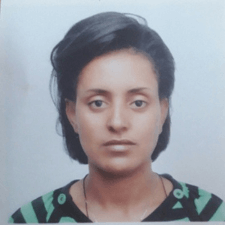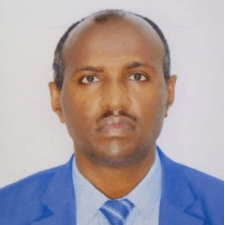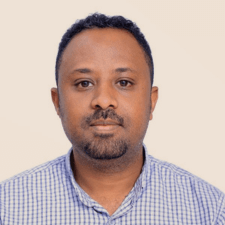Q&A: Strategic approaches to improve access to wasting treatment in Ethiopia
Integrating early detection and treatment of child wasting into primary health care
[Editor’s Note: This blog post is based on the webinar, “Integrating Early Detection and Treatment of Wasting into Routine Primary Healthcare in Ethiopia: Experience and Next Steps,” hosted by the Ministry of Health in collaboration with R4D on March 23, 2023, which focused on Ethiopia’s experience in developing and operationalizing a national action plan for the integration of wasting into routine health services. The following is an abridged version of the conversation.]
Ethiopia has shown leadership in nutrition through commitment to the Seqota Declaration, development of the Food and Nutrition Policy, and the Ethiopia’s roadmap for the Global Action Plan for Child Wasting (GAP). However, the prevalence of wasting among children is still unacceptably high at 11% nationally. Many children require treatment — a large task that requires both humanitarian support and long-term health system strengthening to deliver quality nutrition services.
In January 2023, the Ministry of Health (MOH) convened regional nutrition focal points to develop an operational plan for the integration of early detection and treatment of wasting into routine health care services. This was the final step in a consultative, multi-stakeholder process the Ministry undertook to develop the national plan using the approach developed by UNICEF and R4D described here. The result of this process was a highly targeted operational plan developed for the next 3 years to ensure preventive services are strengthened and adequate care is provided for beneficiaries in need, including children with moderate or severe wasting, and pregnant and lactating women.
In March 2023, the MOH hosted a webinar to discuss the way forward with partners. An esteemed panel provided insight on key areas of strategic support covered in the plan, summarized here.
Recently there has been a campaign to integrate nutrition and immunization services. What is the vision for this in the future?
 Gelila Zewdu, Senior Nutrition Advisor, MOH, Ethiopia: The coverage of high-impact and low-cost nutrition interventions, such as vitamin A supplementation, deworming, growth monitoring and promotion and nutrition screening are low in many parts of Ethiopia. To help scale up these interventions, last year, the MOH integrated nutrition within Ethiopia’s large-scale national measles campaign targeting children 0-59 months old. The nutrition services integrated are screening for acute malnutrition, vitamin A supplementation (6-59 months) and deworming (24-59 months).
Gelila Zewdu, Senior Nutrition Advisor, MOH, Ethiopia: The coverage of high-impact and low-cost nutrition interventions, such as vitamin A supplementation, deworming, growth monitoring and promotion and nutrition screening are low in many parts of Ethiopia. To help scale up these interventions, last year, the MOH integrated nutrition within Ethiopia’s large-scale national measles campaign targeting children 0-59 months old. The nutrition services integrated are screening for acute malnutrition, vitamin A supplementation (6-59 months) and deworming (24-59 months).
The integration initiative was a huge success. More than 15 million children between the ages of 6-59 months were screened for malnutrition. More than 88,000 children with a MUAC measure of less than 11.5 centimeters were identified and referred. More than 13 million children received vitamin A supplementation (with 92.2% coverage), while more than 8 million children received deworming tablets (with 95.3% coverage).
A large part of the success was thanks to our partner commitments, where a total of US $1.8 million was mobilized to support the nutrition integration, plus in-kind contributions of Vitamin A capsules, vehicles, and MUAC tape were received from partners. Nationwide, about 407 experts from partners and government participated in the campaign. The measles campaign is an opportunity to reach many more households with nutrition services annually and we hope for continued partnership to help strengthen the program.
The MOH has made an impressive commitment to transition ready-to-use therapeutic food (RUTF) supply function to the government Ethiopia Pharmaceutical Supply Agency (EPSA) system. Can you please share your experience on integration of RUTF into the national supply chains?
 Stanley Chitekwe, Chief of Nutrition, UNICEF, Ethiopia: We look at integration from two levels — federal and regional levels. At the federal level, we are advocating for the inclusion of RUTF in the Essential Medicines List which would help it to be prioritized in the government budget and one of the items to be integrated into the Ethiopia Pharmaceutical Supply Agency (EPSA) system.
Stanley Chitekwe, Chief of Nutrition, UNICEF, Ethiopia: We look at integration from two levels — federal and regional levels. At the federal level, we are advocating for the inclusion of RUTF in the Essential Medicines List which would help it to be prioritized in the government budget and one of the items to be integrated into the Ethiopia Pharmaceutical Supply Agency (EPSA) system.
The second is to carry out a capacity assessment of EPSA in terms of integrating RUTF. One key recommendation here is the need to establish a big warehouse to house RUTF sourced locally (30%) and outside of the country (70%). New warehousing is required because we cannot simply integrate into the existing warehouse given the size of RUTF.
It is at the regional level where we see the complete picture of integration currently. Once we receive the RUTF, we deliver it through the regions. The regions then distribute it to zonal levels, from zonal to woreda levels, and eventually to kebele levels, where we have the lowest levels of health facilities, the health posts. This whole process would require around $10 million every year that the government is willing to invest for the final distribution of RUTF to the point of use — and this is a very strong illustration of integration.
Additionally, the government has invested $1.3 million this fiscal year to procure RUTF through the UNICEF Child Nutrition Fund, which matches this investment to make it $2.6 million. This is a good starting point for the government to use domestic resources for the procurement of RUTF.
What is the contribution of early detection and treatment of wasting for stunting reduction? What are the benefits of integrating wasting into the routine health care system?
 Dr. Sisay Sinamo Boltena, Senior Programme Manager, Seqota Declaration, Federal Programme Delivery Unit, Ethiopia: There is strong evidence that wasting leads to stunting and to some extent stunting also leading to wasting. It is critical to understand when children are exposed to malnutrition so that we can understand where to put our investment and emphasis for prevention of wasting. Within the health system, growth monitoring and promotion and mid-upper arm circumference (MUAC) screening help to identify malnutrition, allowing for intervention earlier which can help prevent cases from worsening. A priority for the health system is to ensure children who are treated for wasting do not revert to wasting once the treatment regimen is completed. This can be done through promoting optimum nutrition practices at household levels and through developing strong community-based nutrition promotion activities.
Dr. Sisay Sinamo Boltena, Senior Programme Manager, Seqota Declaration, Federal Programme Delivery Unit, Ethiopia: There is strong evidence that wasting leads to stunting and to some extent stunting also leading to wasting. It is critical to understand when children are exposed to malnutrition so that we can understand where to put our investment and emphasis for prevention of wasting. Within the health system, growth monitoring and promotion and mid-upper arm circumference (MUAC) screening help to identify malnutrition, allowing for intervention earlier which can help prevent cases from worsening. A priority for the health system is to ensure children who are treated for wasting do not revert to wasting once the treatment regimen is completed. This can be done through promoting optimum nutrition practices at household levels and through developing strong community-based nutrition promotion activities.
In terms of leadership and governance, data on wasting treatment is very important for health sector decision-making at the community level. For instance, we have the multisectoral coordination system at the woreda level. We need to see how we are using the available data as early warning information to take timely action to prevent further deterioration of the situation.
Usually, we respond to emergencies when things deteriorate further rather than early. For instance, we can use the MUAC screening data for early warning and response decision making. We can also use data for providing economic empowerment that would help poor families build resiliency and sustain the achievements once they come out of the treatment of wasting.
What are some of the successful ways to scale up services for the prevention and treatment of child wasting?
 Muluneh Girma, Head of Department — Nutrition and Health, Action Against Hunger, Ethiopia: There are many promising initiatives underway. Family MUAC is one of the innovative approaches gaining popularity in Ethiopia, especially after the occurrence of COVID-19. The approach primarily aims to enhance the capacity of mothers and caretakers of children under 5 to detect acute malnutrition and refer cases to the nearest health facilities as soon as possible. Operational research is underway on the impact of Family MUAC on early identification and referrals, treatment outcomes, and screening and/or treatment coverage as compared to standard health care worker-led community-based screenings.
Muluneh Girma, Head of Department — Nutrition and Health, Action Against Hunger, Ethiopia: There are many promising initiatives underway. Family MUAC is one of the innovative approaches gaining popularity in Ethiopia, especially after the occurrence of COVID-19. The approach primarily aims to enhance the capacity of mothers and caretakers of children under 5 to detect acute malnutrition and refer cases to the nearest health facilities as soon as possible. Operational research is underway on the impact of Family MUAC on early identification and referrals, treatment outcomes, and screening and/or treatment coverage as compared to standard health care worker-led community-based screenings.
Another promising approach is the Mami Care Pathway (the management of small and nutritionally at-risk infants under the age of 6 months and their mothers) implemented in refugee camps. The approach offers special opportunity for vulnerable groups to access holistic and integrated health, nutrition and mental health social services. This kind of service can be integrated and scaled up in the health care system of host communities to enhance the early detection and treatment of child wasting and ensure the continuum of care within the existing facilities.
Operational research is underway modeling how the country’s Early Warning System (EWS) can identify potential risks of hunger and malnutrition before they occur, leveraging secondary data from various sources in disaster (e.g., drought and flood) prone areas. This will enable anticipatory actions to be taken proactively to prevent hunger and malnutrition.
In terms of RUTF, high level conversations between the MOH and the Emergency Nutrition Cluster Unit (ENCU) have occurred, and a concept note is being developed on the use of plant based RUTF. This presents an opportunity to create an alternative solution to treat wasting in Ethiopia and elsewhere.
Call to action
Over the next three years, the MOH nutrition integration plan requires the mobilization of 3.2 billion ETB, which is around 60 million USD. The MOH is committed to the action plan and has embedded wasting integration within the MOH’s annual plan as a priority area with domestic resources allocated.
Still, fulfilling the action plan requires support from all development partners through funding, technical assistance, capacity strengthening, collaborative learning and adaptation and evidence generation to strengthen programming and planning.
Catch up on the series
- Improving access to malnutrition treatment within primary health care
- Strategic opportunities to scale ready-to-use therapeutic foods
- Optimizing primary health care to treat child wasting
- How the Philippines integrated malnutrition management into its health system
- Q&A: Strategic approaches to improve access to wasting treatment in Ethiopia
Photo © Amy Fowler/USAID













